Here is something to get you going. The code is quite repetitive, the trick is to:
1) Create a Nx2 array to store the moving point/line's coordinates, updated as the sliders are moved. The 1st column is the x-coordinate and the 2nd is the y-coordinate.
2) Create a listener object associated with each slider to produce a smooth, continuous drawing.
3) After issuing the hold on command, only display the last row of the array containing the positions.
Here I use a scatter plot but I'll let you figure out how to use a LineSeries object instead. That's easy :)
Also you can customize the appearance of the points. Here I made the starting point a big black dot, and each time the slider is release (when its callback is executed) a blue dot is displayed.
function DrawMarkerLine(~)
clc
clear
hFig = figure('Position',[100 100 400 400],'Units','normalized');
%// create axes with handle
handles.axes1 = axes('Position', [0.2 0.2 0.6 0.6],'XLimMode','manual','YLimMode','manual','XLim',[-4 4],'YLim',[-4 4]);
%// create x slider with handle
handles.x_slider = uicontrol('style', 'Slider','Min',-4,'Max',4,'Value', 0,'units','normalized','position', [0.2 0.08 0.6 0.08], 'callback', @(s,e) UpdateX);
handles.SliderxListener = addlistener(handles.x_slider,'Value','PostSet',@(s,e) XListenerCallBack);
%// create y slider with handle
handles.y_slider = uicontrol('style', 'Slider', 'Min', -4, 'Max', 4, 'Value', 0, 'units', 'normalized', 'position', [0.08 0.2 0.08 0.6], 'callback', @(s,e) UpdateY);
handles.SlideryListener = addlistener(handles.y_slider,'Value','PostSet',@(s,e) YListenerCallBack);
%// Initialize Nx2 array (x and y coordinates) containing all the positions
handles.AllPositions = [0 0];
handles.Sc = scatter(handles.axes1,handles.AllPositions(1,1),handles.AllPositions(1,2),200,'k','filled');
%// set axis equal to the sliders min and max
set(handles.axes1, 'YLim', [-4 4], 'XLim', [-4 4],'XTick',-4:1:4,'YTick',-4:1:4);
guidata(hFig,handles);
%// Listeners callbacks followed by sliders callbacks. They are all the ame
%// basically.
function XListenerCallBack
handles = guidata(hFig); %// Get handles.
%// Get position of both sliders
xval = (get(handles.x_slider,'value'));
yval = (get(handles.y_slider,'value'));
%// Concatenate all values
handles.AllPositions = [handles.AllPositions; xval yval];
hold on
%// Draw markers
scatter(handles.AllPositions(end,1),handles.AllPositions(end,2),40,'r')
drawnow
set(handles.axes1, 'YLim', [-4 4], 'XLim', [-4 4]); %// Set axis limits
guidata(hFig,handles);
end
function YListenerCallBack
handles = guidata(hFig);
xval = (get(handles.x_slider,'value'));
yval = (get(handles.y_slider,'value'));
handles.AllPositions = [handles.AllPositions; xval yval];
hold on
%// Draw markers
scatter(handles.AllPositions(end,1),handles.AllPositions(end,2),40,'r')
drawnow
set(handles.axes1, 'YLim', [-4 4], 'XLim', [-4 4]); %// Set axis limits
guidata(hFig,handles);
end
function UpdateY(~)
handles = guidata(hFig); %// Get handles.
%// Get position of both sliders
xval = (get(handles.x_slider,'value'));
yval = (get(handles.y_slider,'value'));
handles.AllPositions = [handles.AllPositions; xval yval];
hold on
%// Draw markers
scatter(handles.AllPositions(end,1),handles.AllPositions(end,2),100,'b','filled')
drawnow
set(handles.axes1, 'YLim', [-4 4], 'XLim', [-4 4]); %// Set axis limits
guidata(hFig,handles);
end
function UpdateX(~)
handles = guidata(hFig); %// Get handles.
%// Get position of both sliders
xval = (get(handles.x_slider,'value'));
yval = (get(handles.y_slider,'value'));
handles.AllPositions = [handles.AllPositions; xval yval];
hold on
%// Draw markers
scatter(handles.AllPositions(end,1),handles.AllPositions(end,2),100,'b','filled')
drawnow
set(handles.axes1, 'YLim', [-4 4], 'XLim', [-4 4]); %// Set axis limits
guidata(hFig,handles);
end
end
Sample output:

Note that the slower you move, the closer points will be from one another on the plot. I moved quite fast, hence the large space between some points.
Have fun!

